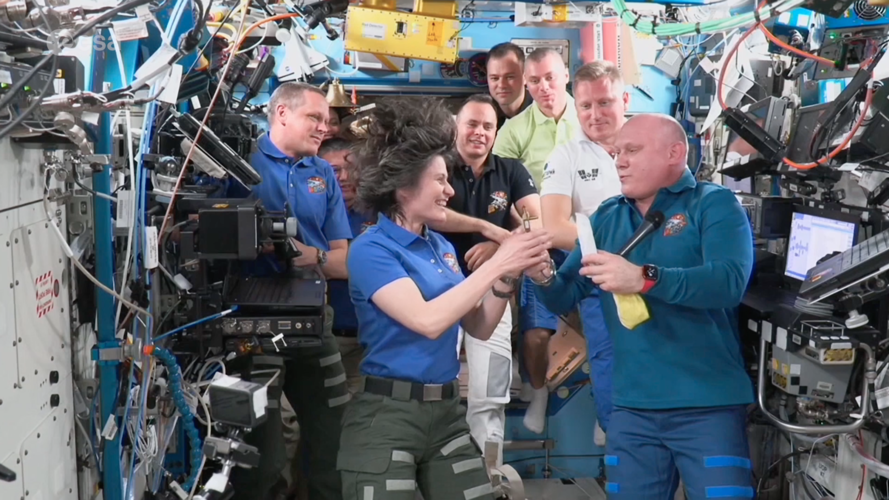
Copernical Team
Run the Solar System in 20 km
 Image:
Run the Solar System in 20 km
Image:
Run the Solar System in 20 km Satellites detect methane plume in Nord Stream leak

Following unusual seismic disturbances in the Baltic Sea, several leaks were discovered last week in the underwater Nord Stream 1 and 2 gas pipelines, near Denmark and Sweden. Neither pipeline was transporting gas at the time of the blasts, but they still contained pressurised methane – the main component of natural gas – which spewed out producing a wide stream of bubbles on the sea surface.
With the unexplained gas release posing a serious question about the incident’s environmental impact, a suite of complementary Earth observation satellites carrying optical and radar imaging instruments were called
Minerva Mission highlights
 Video:
00:05:03
Video:
00:05:03
ESA astronaut Samantha Cristoforetti will soon complete her second mission to the International Space Station, Minerva.
She was launched from Kennedy Space Center in late April, and since then has supported numerous European and international science experiments, as well as taken responsibility for all operations within the US Orbital Segment. In July 2022 she performed her first spacewalk, during which she carried out work in the Russian segment to bring the European Robotic Arm into operation. At the end of September 2022, she became the first European woman to hold the role of crew commander on the Station.
Cosmic ray protons reveal new spectral structures at high energies
 Cosmic rays constitute high-energy protons and atomic nuclei that originate from stars (both within our galaxy and from other galaxies) and are accelerated by supernovae and other high-energy astrophysical objects. Our current understanding of the Galactic cosmic ray energy spectrum suggests that it follows a power-law dependence, in that the spectral index of protons detected within a certain e
Cosmic rays constitute high-energy protons and atomic nuclei that originate from stars (both within our galaxy and from other galaxies) and are accelerated by supernovae and other high-energy astrophysical objects. Our current understanding of the Galactic cosmic ray energy spectrum suggests that it follows a power-law dependence, in that the spectral index of protons detected within a certain e Supercomputer simulations reveal new possibilities for the Moon's origin
 Our pioneering scientists from the Institute for Computational Cosmology used supercomputer simulations to reveal an alternate explanation for the Moon's origin, as a satellite placed immediately into orbit following a giant impact between Earth and a Mars-sized body.
The researchers created the highest resolution simulations yet produced to study the Moon's origin 4.5 billion years ago.
Our pioneering scientists from the Institute for Computational Cosmology used supercomputer simulations to reveal an alternate explanation for the Moon's origin, as a satellite placed immediately into orbit following a giant impact between Earth and a Mars-sized body.
The researchers created the highest resolution simulations yet produced to study the Moon's origin 4.5 billion years ago. The fountain of life: Water droplets hold the secret ingredient for building life
 Purdue University chemists have uncovered a mechanism for peptide-forming reactions to occur in water - something that has puzzled scientists for decades.
"This is essentially the chemistry behind the origin of life," said Graham Cooks, the Henry Bohn Hass Distinguished Professor of Analytical Chemistry in Purdue's College of Science."This is the first demonstration that primordial molecu
Purdue University chemists have uncovered a mechanism for peptide-forming reactions to occur in water - something that has puzzled scientists for decades.
"This is essentially the chemistry behind the origin of life," said Graham Cooks, the Henry Bohn Hass Distinguished Professor of Analytical Chemistry in Purdue's College of Science."This is the first demonstration that primordial molecu Africa in space: continent has a lot to gain, but proper plans must be put in place
 Every year in October nearly 100 countries organise activities to mark World Space Week. The theme this year is space and sustainability. In this interview, Adejuwon Soyinka, West Africa regional editor at The Conversation Africa, asks Etim Offiong about how far Africa has come in the space age and what benefits the continent stands to gain from its investment in space technology.
Russia's
Every year in October nearly 100 countries organise activities to mark World Space Week. The theme this year is space and sustainability. In this interview, Adejuwon Soyinka, West Africa regional editor at The Conversation Africa, asks Etim Offiong about how far Africa has come in the space age and what benefits the continent stands to gain from its investment in space technology.
Russia's SwRI creates Space Sector with two new divisions to support space research and development
 Southwest Research Institute's Space Science and Engineering Division, with 465 employees in three states, has been restructured to create two new technical divisions. Dr. James L. Burch, vice president of the Space Science Division, will become Senior Vice President leading SwRI's new Space Sector organization, encompassing all three divisions.
Dr. Robin Canup will lead the new Solar Syst
Southwest Research Institute's Space Science and Engineering Division, with 465 employees in three states, has been restructured to create two new technical divisions. Dr. James L. Burch, vice president of the Space Science Division, will become Senior Vice President leading SwRI's new Space Sector organization, encompassing all three divisions.
Dr. Robin Canup will lead the new Solar Syst Sols 3614-3615: Chemin's Moment To Shine
 The Curiosity team continues with our "Canaima" drill campaign. [Today's] 2-sol plan will provide our first look at the minerals present within this sample. This is complementary but different than the chemical compositions provided by ChemCam and APXS before we drilled. CheMin uses X-ray diffraction to confirm crystalline mineralogy, they direct a beam of X-rays, as fine as a human hair, throug
The Curiosity team continues with our "Canaima" drill campaign. [Today's] 2-sol plan will provide our first look at the minerals present within this sample. This is complementary but different than the chemical compositions provided by ChemCam and APXS before we drilled. CheMin uses X-ray diffraction to confirm crystalline mineralogy, they direct a beam of X-rays, as fine as a human hair, throug Tiangong space station marks key step in assembly
 The Wentian lab module of China's Tiangong space station has been repositioned to dock with a radial port on the station's Tianhe core module on Friday afternoon, which marked a key step in Tiangong's in-orbit assembly, according to the China Manned Space Agency.
The agency said in a news release that during the hour-long operation that finished at 12:44 pm, Wentian was moved from the axia
The Wentian lab module of China's Tiangong space station has been repositioned to dock with a radial port on the station's Tianhe core module on Friday afternoon, which marked a key step in Tiangong's in-orbit assembly, according to the China Manned Space Agency.
The agency said in a news release that during the hour-long operation that finished at 12:44 pm, Wentian was moved from the axia 
